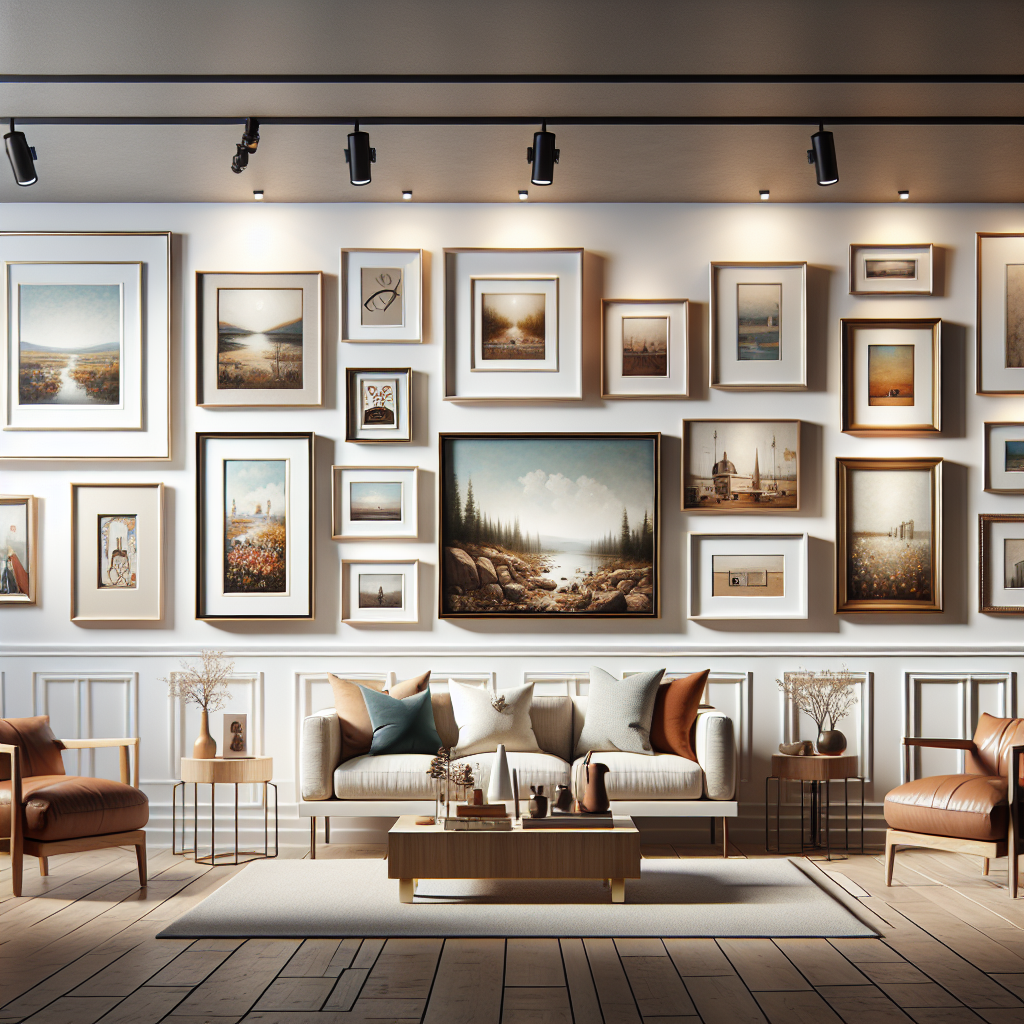
Looking to add some personality and style to your space? Hanging art is a great way to make a statement and showcase your personal taste. But before you grab a hammer and nails, it’s important to consider a few tips for hanging art to ensure it looks its best. From selecting the right artwork to finding the perfect placement, we’ll explore some valuable insights to help you create a visually stunning and well-balanced display in your home. Whether you’re a design enthusiast or simply looking for some inspiration, these tips will help you achieve a beautifully curated space that reflects your unique style.

Choosing the Right Artwork
When it comes to choosing artwork for your home, there are several factors you should consider. The first is the style and size of the room. Take a look at the overall design and aesthetics of the space. Is it modern and minimalist, or is it more traditional and ornate? This will help you determine the style of artwork that would best complement the room. Additionally, consider the size of the room and the wall where you plan to hang the art. A small, delicate piece may get lost on a large wall, while a large, bold piece could overwhelm a smaller space.
Another important consideration when choosing artwork is reflecting your personal taste. Art is subjective, and what one person finds beautiful, another may not. Select pieces that resonate with you and reflect your personality and interests. This will ensure that you feel a connection to the art and that it adds value and meaning to your space.
In addition to personal taste, it’s important to choose artwork that complements the existing decor in your home. Take a look at the colors, patterns, and textures already present in the room. You want your art to enhance and harmonize with these elements, rather than clash or compete with them. Consider selecting artwork that incorporates or complements the color palette of the room to create a cohesive and visually pleasing look.
Finding the Perfect Placement
Once you have chosen the right artwork for your space, it’s time to think about where and how to hang it. Placement is key to ensuring that your art is showcased in the best possible way.
Start by taking into account eye level. The center of the artwork should be at eye level for the average person to create a comfortable viewing experience. If you have particularly high or low ceilings, you may need to make adjustments accordingly. Consider the height of the people in your household and try to find a happy medium that works for everyone.
Consider the focal point of the room. In most cases, the art should be placed on a wall that serves as a focal point, such as above a fireplace or behind a sofa. This helps draw attention to the artwork and creates a visually pleasing arrangement. Avoid placing art on walls that are heavily obscured or not easily visible, as this can diminish its impact.
Create visual balance by considering the size and placement of other objects in the room. For example, if you have a large piece of furniture on one side of the room, consider balancing it out with a larger piece of art on the opposite wall. This helps create a sense of harmony and proportion in the space.
Leave space for breathing room around the artwork. Crowding it with other decorative elements or furniture can make it feel crowded and overwhelmed. Allow some space around the art to let it stand out and shine on its own.
Preparing the Wall
Before hanging your artwork, it’s important to properly prepare the wall to ensure a secure and stable installation.
Start by cleaning the wall surface. Dust and debris can prevent adhesive materials from adhering properly and can lead to a less secure hang. Use a soft dry cloth or duster to gently remove any dirt or dust. If you notice any stains or marks on the wall, consider using a mild soap solution to clean the area.
If there are any holes or imperfections in the wall, be sure to patch them up before hanging art. Small holes can be filled with spackling paste or putty and sanded down for a smooth finish. Larger holes may require more extensive repairs, such as patching with drywall or using a wall repair kit. It’s important to have a smooth and even surface to hang your art.
Use a level and measuring tape to ensure that your artwork is hung straight and at the appropriate height. It’s easy for things to appear crooked when eyeballing it, so taking the time to measure and use a level will result in a more professional and polished look.
For heavy or large pieces of art, consider using wall anchors to provide extra support. Wall anchors help distribute the weight of the art more evenly and reduce the risk of the artwork falling or causing damage to the wall.
Appropriate Hanging Hardware
Choosing the right hanging hardware is essential to ensure that your artwork is securely and safely mounted on the wall.
For framed artwork, choose the right hanging wire or cord. This can be determined by the weight and size of the frame. A thin wire may be suitable for smaller and lighter frames, while thicker wire or cord should be used for larger and heavier frames. Make sure to properly attach the wire or cord to the frame using appropriate hardware and knots to prevent it from coming loose.
D-rings or sawtooth hangers are commonly used for frames without a wire or cord. D-rings are usually attached to the back of the frame and allow for easy hanging on a hook or nail. Sawtooth hangers are small metal pieces with serrated edges that can be nailed into the back of the frame. They provide a secure hold and are ideal for smaller frames.
Consider art hanging systems for added versatility. These systems consist of tracks or rails installed on the wall, allowing you to easily hang and move artwork without creating new holes. They are particularly useful for those who like to frequently change their art or rearrange it.
For lighter pieces of art, picture hanging hooks or nails can be used. These can be easily hammered into the wall and provide a simple and cost-effective solution for hanging smaller and lighter pieces.

Proper Art Placement Techniques
Knowing the proper techniques for art placement can greatly enhance the visual impact of your artwork.
Start by creating a center point. This can be the center of the wall, a piece of furniture, or another focal point in the room. Position the center of the artwork at this point to create a visually balanced and pleasing arrangement.
For multiple art pieces, consider using groupings. Grouping artwork together can create a cohesive and dynamic display. Arrange the pieces in a way that complements the overall composition and proportion of the room. Play around with different layouts and spacing until you find the arrangement that suits your taste and the space.
Experiment with arrangement patterns to add visual interest. You can hang art in a straight line, create a grid pattern, or arrange it in a more organic and asymmetrical manner. The key is to find a pattern that enhances the art and complements the style of the room.
Consider the use of symmetry or asymmetry. Symmetrical arrangements create a sense of balance and order, while asymmetrical arrangements can add a touch of dynamism and creativity. Choose the approach that aligns with your personal style and the overall vibe of the space.
Hanging Art in Different Spaces
Each room in your home may require a slightly different approach to hanging art. Let’s explore some tips for hanging art in common spaces.
Living Room
The living room is often a central gathering space in the home, so it’s important to hang art that creates a welcoming and comfortable atmosphere. Consider placing artwork above the sofa or fireplace to serve as a focal point. Opt for larger pieces to make a statement, or create a gallery wall with a mix of smaller frames for a more eclectic look. Don’t be afraid to showcase your personal taste and style in this space.
Bedroom
The bedroom is a sanctuary for relaxation and personal expression. Choose Artwork that reflects your personality and creates a soothing environment. Consider hanging art above the bed to create a focal point and add visual interest. Select pieces with calming colors or subjects to promote a sense of serenity and tranquility. If you prefer a more minimalist look, a single large-scale piece above the bed can create a clean and stylish aesthetic.
Kitchen
While the kitchen may not be the first space that comes to mind for displaying artwork, it can be a great opportunity to add personality and style to the room. Consider hanging art on bare walls or above countertops to create visual interest. Choose pieces that complement the color scheme or theme of your kitchen. You can also opt for artwork related to food, cooking, or family to enhance the atmosphere and make the space feel more inviting.
Home Office
In a home office, art can serve as both a source of inspiration and a way to personalize the space. Hang artwork that motivates and energizes you, such as quotes or images that reflect your professional goals and aspirations. Consider placing art in your line of sight to provide visual breaks and reduce eye strain during work hours. It’s also important to choose art that complements the overall aesthetic of your office and promotes a productive and focused environment.

Choosing the Right Frame
The right frame can greatly enhance the impact and visual appeal of your artwork. Consider these factors when choosing a frame for your art.
Start by considering the artwork style. Different art styles may call for different types of frames. For example, a modern and abstract piece may look best in a sleek and minimalist frame, while a traditional or vintage piece may benefit from a more ornate and decorative frame. Consider the mood and style of the artwork and choose a frame that enhances and complements it.
Match the frame to the room’s aesthetic. Take into account the overall design and style of the space when selecting a frame. You want the frame to harmonize with the existing decor, rather than clash or detract from it. Consider the color palette, materials, and finishes in the room when making your decision.
Consider the frame’s material and color. Frames are available in a wide range of materials, including wood, metal, and plastic. Each material has its own unique characteristics and can greatly impact the visual appearance of the artwork. Additionally, consider the color of the frame and how it complements the artwork and the room. Choose a frame color that enhances the colors in the artwork without overpowering them.
Decide between custom frames and pre-made frames. Custom frames offer the advantage of being tailored to the specific dimensions and style of your artwork. They can be more expensive but provide a high level of customization. On the other hand, pre-made frames are more budget-friendly and come in standard sizes and styles. They can be easily found in stores or online and offer a convenient option for framing your art.
Lighting Considerations
Proper lighting is essential for showcasing and preserving your artwork. Consider these lighting tips when displaying your art.
Natural Lighting
Take advantage of natural lighting whenever possible. Natural light can enhance the colors and details of your artwork. Position your art near windows or skylights to maximize the natural light. However, be cautious of direct sunlight, as it can cause fading and damage to the artwork over time. Use curtains or blinds to control the amount of sunlight entering the room and protect your artwork.
Artificial Lighting
Supplement natural light with artificial lighting to create a well-lit and balanced display. Use a combination of ambient, task, and accent lighting to highlight the art and create the desired atmosphere. Track lighting or picture lights can be used to directly illuminate the artwork, while overhead or wall-mounted fixtures can provide general illumination to the room.
Avoid Overexposure to Sunlight
As mentioned earlier, direct sunlight can be harmful to your artwork. Over time, it can cause fading, discoloration, and deterioration of the materials. Avoid hanging art in areas where it will be exposed to direct sunlight for extended periods. If you have no other option, consider using UV-filtering glass or acrylic to protect the artwork from harmful UV rays.
Adjustable Lighting Options
Consider using adjustable lighting options to easily change the intensity and direction of the light. This can allow you to highlight different pieces of art or adjust the lighting based on personal preferences. Dimmers, adjustable track lights, or moveable lamps are all options to consider for added flexibility and control.

Maintaining Artwork
Proper maintenance and care of your artwork can help preserve its beauty and value over time. Follow these tips to keep your art looking its best.
Dust your artwork regularly with a soft brush or microfiber cloth. This will help remove any dust or debris that may accumulate on the surface. Avoid using water or cleaning solutions unless specifically recommended by a professional conservator.
Avoid direct contact with moisture. Water or humidity can often damage artwork, causing warping, mold growth, or color bleeding. Hang your art in areas with stable humidity levels, away from sources of moisture such as kitchens, bathrooms, or humidifiers.
Frame cleaning and care are essential for maintaining the condition of your artwork. Regularly inspect the frame for any signs of damage or wear. Clean the frame with a soft cloth or duster to remove any dust or dirt. If the frame becomes damaged or worn, consider seeking professional frame restoration or repair services.
Consider art conservation for valuable or fragile artworks. Art conservation involves employing specialized techniques and materials to restore and preserve artwork. If you have valuable pieces or artworks made with delicate materials, consulting an art conservation professional can ensure that they are properly cared for and protected.
Seeking Professional Advice
While hanging art can be a fun and rewarding DIY project, there may be instances where seeking professional advice or assistance is beneficial.
Consider consulting an art professional for guidance when choosing artwork. They can provide valuable insights and recommendations based on your personal taste, budget, and preferences. They can also help you navigate the art market and source pieces that meet your criteria.
If you have large or valuable artworks, hiring a professional art installer can ensure a safe and secure installation. Art installers have the knowledge and expertise to handle delicate and heavy pieces, and they can ensure that the artwork is hung securely and at the correct height.
Art placement consultants specialize in creating visually pleasing and harmonious art arrangements. They can help you choose the right positioning, scale, and arrangement for your artwork to create a cohesive and appealing display. They can also provide advice on framing, lighting, and other aspects of art placement.
Art consignment services can be useful if you are looking to sell or display your artwork. Consignment services connect artists, collectors, and buyers, making it easier to sell or showcase your artwork. They often have a network of potential buyers or galleries and can assist with marketing, pricing, and logistics.
In conclusion, choosing and hanging artwork involves careful consideration of various factors, such as the style and size of the room, personal taste, existing decor, color palette, and placement techniques. Properly preparing the wall and using appropriate hanging hardware are crucial for a secure and stable installation. Lighting, maintenance, and seeking professional advice can further enhance the enjoyment and longevity of your artwork. So go ahead, unleash your creativity, and turn your walls into a canvas for artistic expression!

